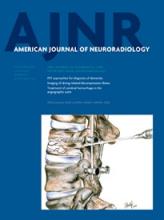Abstract
BACKGROUND AND PURPOSE: Flat panel detector CT images are degraded by streak artifacts caused by radiodense implanted materials such as coils or clips. A new metal artifacts reduction prototype algorithm has been used to minimize these artifacts. The application of this new metal artifacts reduction algorithm was evaluated for flat panel detector CT imaging performed in a routine clinical setting.
MATERIALS AND METHODS: Flat panel detector CT images were obtained from 59 patients immediately following cerebral endovascular procedures or as surveillance imaging for cerebral endovascular or surgical procedures previously performed. The images were independently evaluated by 7 physicians for metal artifacts reduction on a 3-point scale at 2 locations: immediately adjacent to the metallic implant and 3 cm away from it. The number of visible vessels before and after metal artifacts reduction correction was also evaluated within a 3-cm radius around the metallic implant.
RESULTS: The metal artifacts reduction algorithm was applied to the 59 flat panel detector CT datasets without complications. The metal artifacts in the reduction-corrected flat panel detector CT images were significantly reduced in the area immediately adjacent to the implanted metal object (P = .05) and in the area 3 cm away from the metal object (P = .03). The average number of visible vessel segments increased from 4.07 to 5.29 (P = .1235) after application of the metal artifacts reduction algorithm to the flat panel detector CT images.
CONCLUSIONS: Metal artifacts reduction is an effective method to improve flat panel detector CT images degraded by metal artifacts. Metal artifacts are significantly decreased by the metal artifacts reduction algorithm, and there was a trend toward increased vessel-segment visualization.
ABBREVIATIONS:
- FDCT
- flat panel detector CT
- MAR
- metal artifacts reduction
- © 2014 by American Journal of Neuroradiology







